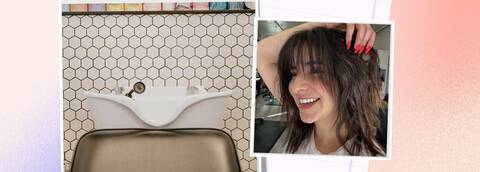The Reverse Washing Method, also known as reverse hair washing, is a hair cleaning approach where you apply conditioner to your hair first, followed by a gentle shampoo cleanse. This innovative technique is particularly beneficial for individuals with fine, damaged, or overprocessed hair, as conventional washing methods can strip away natural oils, leaving the hair dry and fragile.
By reversing the order of conditioner and shampoo, the reverse washing method aims to restore moisture, add volume, and improve the overall health and appearance of the hair.
Introduction To The Reverse Washing Method
Discover the Reverse Washing Method, a game-changing technique for healthier hair. By applying conditioner first and following with a gentle shampoo cleanse, you can maintain your
What Is the Reverse Shampoo Method?
The reverse shampoo method, also known as reverse washing, is a haircare technique that involves switching the order of using shampoo and conditioner during your hairwashing routine. Instead of applying shampoo first and then conditioner, you apply conditioner before shampoo with this method.
Benefits Of The Reverse Washing Method
The reverse washing method offers several benefits for your hair:
- Improved hair hydration: By applying conditioner first, your hair will receive intense moisture and hydration, resulting in softer and more manageable strands.
- Reduced product buildup: The reverse method helps to eliminate any excess product residue from your hair, leaving it feeling lighter and cleaner.
- Enhanced hair volume: This technique can help add volume to your hair, making it appear fuller and more voluminous.
- Gentler on fine or oily hair: Reverse washing can be particularly beneficial for those with fine or oily hair as it provides a more gentle cleanse while still giving shine and bounce.
The reverse washing method can transform your hair care routine and give you the healthy, lustrous hair you’ve always wanted. It’s important to note that this method may not suit everyone or every hair type. Experimenting and finding what works best for your hair is always recommended.

How To Use The Reverse Washing Method
Discover the benefits of the reverse washing method and make it work for you! This innovative approach involves applying conditioner to your hair first, followed by a gentle shampoo cleanse. It can provide hydration, nourishment, and detangling, creating shiny, voluminous strands.
Should You Reverse Condition Wet or Dry Hair?
For the best results, wet your hair. Ensure it is thoroughly soaked because putting conditioner on damp or dry hair makes it difficult to spread. Squeeze out a dollop of conditioner on your palm and apply it evenly, starting from the ends and working towards the mid-lengths. Avoid the roots and scalp.
Steps To Reverse Hair Washing
- Start by wetting your hair thoroughly.
- Apply a small amount of shampoo to your scalp and gently massage it.
- Rinse out the shampoo thoroughly.
- Squeeze out excess water from your hair.
- Add a dollop of conditioner to your ends and mid-lengths, avoiding the roots.
- Leave the conditioner in for a few minutes to allow it to penetrate the hair shaft.
- Rinse out the conditioner thoroughly.
- If desired, you can follow up with a leave-in conditioner or other styling products.
Can We Do a Reverse Hair Wash With Oily Hair?
“Since some types of conditioner can weigh hair down—especially fine, limp, or otherwise more oily or greasy hair—reverse hair washing can be more gentle than traditional washing and offer more shine, volume, and softness, as well as bounce and body,” says Berkovitz.
Pros And Cons Of Reverse Washing Method


Frequently Asked Questions Of The Reverse Washing Method: Make It Work For You!
Can I do reverse hairwashing every day?
Reverse hair washing is not recommended for every day. Experts suggest doing it once every other week or even once a month to avoid over-drying your hair. It’s a method where you apply conditioner first, followed by shampoo, and it can provide hydration, nourishment, and detangling benefits.
Should You Reverse Condition Wet Or Dry Hair?
For best results, reverse condition wet hair. Wet hair ensures even distribution of conditioner. Start from the ends, working towards the mid-lengths, avoiding the roots and scalp. Reverse hair washing gives shine, volume, and softness, especially for oily or greasy hair.
Do it once every other week or once a month.
Can We Do a Reverse Hair Wash With Oily Hair?
Reverse hair washing can be done with oily hair. It can be gentler than traditional washing, offering shine, volume, and softness. However, it is not recommended that it be done every time. Reverse hair washing involves applying conditioner first and a gentle shampoo cleanse.
Does Washing Your Hair Upside Down Make It Less Greasy?
Washing your hair upside down can make it less greasy. According to experts, it allows you to shampoo your hair from different angles and ensure the entire scalp area is properly cleansed. This can help prevent an oily scalp caused by improper application of shampoo.
Conclusion
To wrap up, the reverse washing method offers a unique approach to hair cleansing that can produce excellent results for those looking for shiny, voluminous strands. By applying conditioner before shampooing, you can add extra nourishment and hydration while still effectively cleansing your hair.
However, it’s important to note that reverse washing should not be done with every wash. Experts recommend incorporating it into your routine once every other week or even once a month. So try it and see if this technique works for you and enhances the health and appearance of your hair.
Say goodbye to dry, fragile strands, and hello to beautiful, voluminous locks!
DIY hair oils are some of the most important ingredients to have in your beauty arsenal. They add shine, manage frizzy hair, and help improve your hair health.